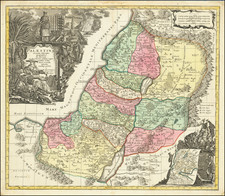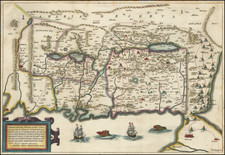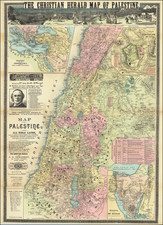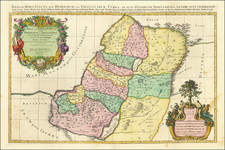At the top, the images show two altars. At the bottom, Aarons vestments.
The text title transates as follows:
- "Altare holocasti secundum latinos." - This can be translated to "The altar of burnt offering according to the Latins."
- "Altare holocasi secundum hebreos." - This translates to "The altar of burnt offering according to the Hebrews."
The Altar of Burnt Offering, known in Hebrew as the "Mizbeach HaOlah," is described in the Hebrew Bible, particularly in the Book of Exodus. It was situated in the outer court of the Tabernacle and later the Temple in Jerusalem. This altar was the primary location for various sacrificial rites conducted by the Israelites.
The altar served as a place where specific animal sacrifices (burnt offerings) were made to atone for sins, express devotion, or fulfill a vow to God. These sacrifices involved the burning of animals, and in some instances, grain offerings, where the smoke symbolized the ascent of the offering to God.
The distinction between the Latin and Hebrew perspectives likely refers to the nuances in understanding or representation of the altar in different traditions. While the basic concept of the altar remains consistent across Jewish and Christian (Latin) traditions, there might be differences in details, rituals, and theological interpretations associated with it in each tradition.
The text refers to certain sacred vestments and artifacts as described in the context of biblical traditions, particularly referencing Aaron, a biblical figure:
"Aaron and his descendants, the priests, were adorned with specific vestments for their ordination. There were four common vestments for all priests, including the lower ranks: the linen ephod, which was worn on the head, its ends pointing upwards in a pointed shape. In addition to these four, the high priest wore four special garments:
- The tunic of woven work, which was tight like a tunic. On its lower edge were bells and pomegranates alternated.
- The ephod without sleeves, extending down to the kidneys, decorated in a beautiful variety.
- The breastplate, which was a double pouch. Within it were twelve precious stones.
- The sash with various colors. The high priest also wore a blue turban on his head; attached to this was a golden plate shaped like a half-moon, inscribed with the Tetragrammaton. It spanned from one ear to the other across the forehead.
God spoke to Moses, instructing him about the bronze basin with its stand, referred to elsewhere as the laver (as Solomon describes it). This was placed between the tent of meeting and the altar of burnt offering. Within it, the priests would wash their hands and feet when preparing to wear the holy garments, to offer sacrifices, and to enter or leave the tent of meeting. Aaron and his sons would also sprinkle themselves with the blood of the sacrificial animal on behalf of the people. When the priest approached the altar to offer incense, he would see reflections from the mirrors of the women who assembled at the entrance of the tent of meeting. Placed around the top of the basin were mirrors; in them, the priests could see if they had any blemishes on their face or garments that needed washing.
God also provided instructions for constructing the Tabernacle. The Tabernacle was dedicated as the dwelling place of God. It was rectangular, enclosed by three walls: north, south, and west. The eastern side was left open, allowing sunlight to illuminate the interior, much like the entrance of many churches which faces the west. Its length was thirty cubits, its width ten, and its height ten. On the southern side were boards made of acacia wood, ten in total. Each board was ten cubits in length, one and a half in width, and two fingers in thickness. They were gilded on both sides and set upon two silver bases. The northern side was made similarly. On the western side, there were six boards."
Hartmann Schedel (1440-1514) was a physician, book collector, and writer whose most famous work, the Liber Chronicarum (Nuremberg Chronicle), included some of the first printed views of many cities in Europe and across the world.
Schedel was born and died in Nuremberg, but he also traveled for his education. From 1456 to 1463 he lived in Leipzig, where he attended the University of Leipzig and earned his MA. From there he went to Padua, where he earned a Doctor of Medicine in 1466. After university, he worked for a time in Nördlingen and then returned to Nuremberg. In 1482 he was elected a member of the Great Council of Nuremberg.
The Chronicle was published in 1493. Besides this major work, one of Schedel’s most enduring legacies is his magnificent manuscript and printed book collection, one of the largest of the fifteenth century. In 1552, Schedel's grandson, Melchior Schedel, sold about 370 manuscripts and 600 printed works from Hartmann Schedel's library to Johann Jakob Fugger. Fugger later sold his library to Duke Albert V of Bavaria in 1571. This library is now mostly preserved in the Bayerische Staasbibliothek in Munich.
Among the surviving portions of Schedel's library are the records for the publication of the Chronicle, including Schedel's contract with Anton Koberger for the publication of the work and the financing of the work by Sebald Schreyer and Sebastian Kammermeister, as well as the contracts with Wohlgemut and Pleydenwurff for the original artworks and engravings. The collection also includes original manuscript copies of the work in Latin and German.











![Asia [with inset:] Palestine or the Holy Land.](https://storage.googleapis.com/raremaps/img/small/93612.jpg)


